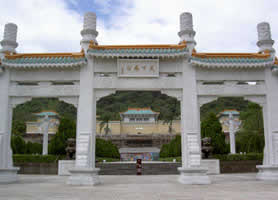The National Palace Museum was established in Beijing on October 10, 1925, shortly after the expulsion of Puyi, the last emperor of China, from the Forbidden City by warlord Feng Yü-hsiang. The articles in the museum consisted of the valuables of the former Imperial family and were moved from place to place in the 1930s and 1940s to prevent them from falling into the hands of the invading Imperial Japanese Army.
During the final years of the Chinese Civil War, the museum collections were moved, under the orders of Chiang Kai-shek, from Beijing's Forbidden City to Taiwan. This removal has always been  controversial with many in Mainland China viewing this as looting while some in Taiwan arguing that had the art not been moved to Taiwan in the 1940s, much would have been destroyed during the Cultural Revolution in the 1960s. With the victory of the Communists, the National Palace Museum was split into two (the part on the mainland, like all other such institutions, lost its "National" designation). The part on the mainland is centered on the Forbidden City. controversial with many in Mainland China viewing this as looting while some in Taiwan arguing that had the art not been moved to Taiwan in the 1940s, much would have been destroyed during the Cultural Revolution in the 1960s. With the victory of the Communists, the National Palace Museum was split into two (the part on the mainland, like all other such institutions, lost its "National" designation). The part on the mainland is centered on the Forbidden City.
The National Palace Museum on Taiwan has also been controversial in Taiwan with many supporters of Taiwan independence regarding it as an unwanted symbol of China-centeredness
During the 1960s and 1970s, the National Palace Museum was used by the Kuomintang to support its claim that the Republic of China was the sole legitimate government of all of China, in that it was the sole preserver of traditional Chinese culture amid the social change and Cultural Revolution in mainland China, and tended to emphasize Chinese nationalism. In recent years, the museum has focused more on local and minority cultures and has included some materials on loan from the People's Republic of China. |
